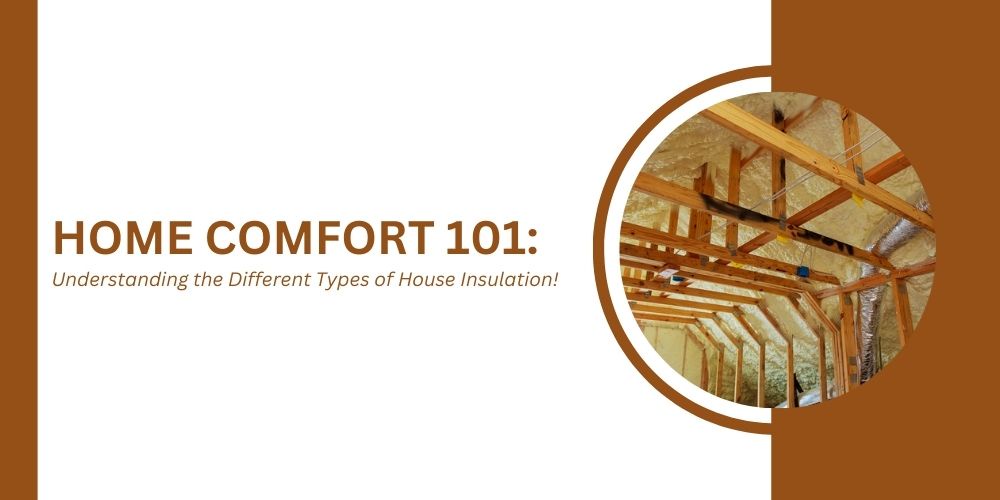Insulation is crucial throughout the year, not just during the colder months. It enhances the comfort of your home, lowers energy expenses, and supports a sustainable lifestyle. Furthermore, choosing the best one for your home can seem daunting with various insulation types available.
But there's no need to worry! We're here to guide you through the ins and outs of insulation. Whether soft, rigid, or any type, we'll explore the different types of house insulation in Douglas County and how they can improve your living environment.
Fiberglass Insulation
Fiberglass insulation is a thermal and acoustic insulating material woven from fine glass fibers. It's made by melting silica sand, limestone, and soda ash and then extruding this molten glass into thin strands.
Pros:
- cost-effective
- non-flammable
- boasts a decent R-value (a measure of thermal resistance)
- easy to install in attics, walls, and floors.
Potential Drawbacks:
- Irritation Risk
- Performance Sensitivity
- Moisture Damage
- Environmental Concerns
Additionally, fiberglass insulation is a jack-of-all-trades, fitting snugly in most areas of your home, from the attic to the basement.
The Green Guardian: Cellulose Insulation
Cellulose insulation is an eco-friendly insulating material made from recycled paper products, primarily newspaper, treated with fire retardants. In addition, residential and commercial buildings use it for effective thermal insulation and soundproofing.
Pros:
- eco-friendly
- provides excellent thermal and acoustic insulation
- less irritating to install
- It's fantastic for retrofitting older homes.
Cons:
- Moisture sensitivity
- Pest attraction
- Higher installation costs
Nonetheless, cellulose insulation is perfect for attics, walls, and areas requiring dense packing to prevent air leaks. It's a win-win for the planet and your peace.
Foam Board Insulation
If your home isn't as comfortable as you want, add foam board insulation to make it cozier. Foam board insulation, or rigid foam insulation, is a lightweight yet strong material made from polystyrene, polyisocyanurate, or polyurethane.
Pros:
- High R-value per inch
- moisture resistance
- easy to cut and fit into various spaces,
- high thermal resistance
Possible Drawbacks:
- the initial cost can be higher
- may not be the best choice for every space
- not for areas with lots of curves or irregular shapes
Nevertheless, these are great for adding insulation to exterior walls with little space or insulating flat roofs.
Spray Foam Insulation
Spray foam insulation is a modern insulating material made from liquid components that expand and solidify when applied, forming durable seals. It effectively creates airtight barriers, enhancing the building's insulation.
Pros:
- excellent air barrier
- can increase structural strength
- perfect for irregular spaces or around obstructions
- never loses its shape
Cons:
- pricier and requires professional installation
- chemicals involved
- need to vacate the premises during the application
To guide you, use closed-cell spray foam for areas prone to moisture and open-cell for general interior insulation.
Mineral Wool Insulation
Mineral wool can refer to rock or slag wool and is rock-solid when it comes to insulation. Made from basalt or industrial waste, it's not just insulating your home; it's also giving materials a second life.
Pros:
- superb fire resistance
- sound dampening properties
- doesn't require additional fire retardants
- moisture-resistant
- doesn't slump over time
Cons:
- It can be more expensive
- more dense, making it harder to install in some areas
Despite the cons, mineral wool insulation is still ideal for areas where fire resistance is a priority, like around chimneys or for soundproofing between rooms or apartments.
Reflective Insulation and Radiant Barriers
Reflective insulation and radiant barriers primarily prevent heat gain by reflecting radiant heat, ideal for hot climates. In contrast, bulk insulation traps air to resist heat flow, making it effective in hot and cold environments.
Pros:
- especially effective in hot climate areas
- lightweight
- easy to install.
Cons:
- effectiveness is highly dependent on proper installation
- don't provide as much insulation in cooler climates
Pair them with other insulation types to maximize reflective insulation and reflective barriers for a one-two punch against heat transfer.
Comparing Insulation Types
When it comes down to it, each insulation type has its stage to shine. Fiberglass is the all-rounder, and cellulose champions the eco-friendly cause. Moreover, foam boards offer solid resistance, spray foam fits anywhere, mineral wool is your fire-resistant buddy, and reflective insulation keeps the heat at bay.
When choosing the appropriate insulation, here are the things you should consider:
- home's layout
- the climate you live in
- your budget
- R-values
- your home's specific needs
On the other hand, to maximize comfort and efficiency, you could consider insulating with a mix of the outlined insulation materials.
Wrapping Up Our Insulation Insights
Picking the proper insulation is a big step towards a more comfortable, energy-efficient home. It's not just about staying warm or cool; it's about creating a sustainable living space that you and your family can enjoy for years. So, take the time to consider your options, and remember, the best choice is the one that meets your unique needs, taking both comfort and the planet into account.


No comments yet